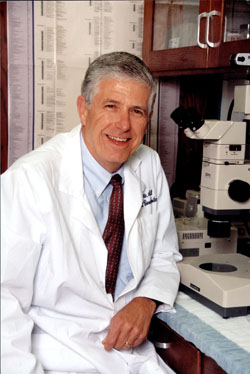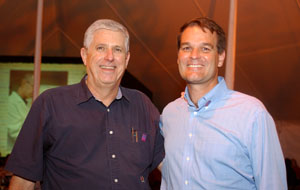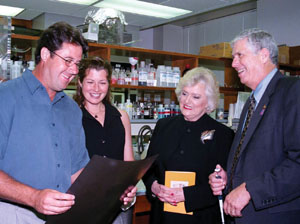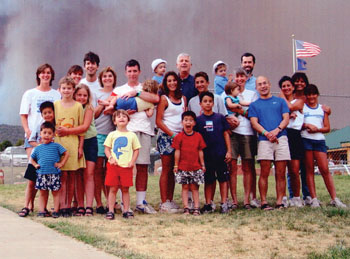
Hal Moses, M.D., says he is excited at the opportunity to spend more time and attention on his research, including a new line of work focusing on the role of neighboring cells in the development and progression of cancers. photo by Alan Mayor
Moses, man of many hats, renowned for getting things done

It's mutual admiration for Moses and Orrin Ingram, who leads Vanderbilt-Ingram's Board of Overseers and the Imagine A World Without Cancer campaign.
photo by Dana Johnson

Vince Gill and Amy Grant toured the Frances Williams Preston Laboratories with Preston and Moses during dedication festivities for the building named in Preston's honor. Moses will continue as director of the laboratories, which are supported by the T.J. Martell Foundation.
photo by Alan Mayor

Family is an important part of Hal and Linda Moses' life. Here the entire Moses clan and extended family pose for a vacation photo in southern Utah near Zion National Park. The smoke behind them is from a nearby wildfire.
photo courtesy of the Moses family
“With apologies to Mark Twain, reports of my retirement have been greatly exaggerated.”
So might Hal Moses, M.D., say as he enters the next phase of his distinguished career as a scientist, cancer center director, scholar and mentor.
“This move is not about freeing up more time — I intend to work as much as I ever have,” said Moses, 66. “It's about freeing up space in my brain to focus more clearly on areas that are very important to me. I am looking forward to re-engaging in the scientific arena, for example. I have managed to maintain a competitive research program, but that's not been easy. And simply keeping up with the literature has been a tremendous challenge.”
Moses will continue his active role on the national cancer scene, as president of the Association of American Cancer Institutes (AACI), member of C-Change (formerly known as the National Dialogue on Cancer) and co-chair of its research committee, and member of numerous advisory boards for cancer centers across the country. He also will advise and raise money for Vanderbilt-Ingram.
“And Linda and I are going to take some real vacations,” he said.
Ray DuBois, M.D., Ph.D., who will take the reins of Vanderbilt-Ingram on Jan. 1, said he is daunted by following in Moses' footsteps but comforted that he won't be far down the hall when guidance is needed. “Hal is the architect of the Vanderbilt-Ingram Cancer Center as we know it today,” DuBois said. “Everything we have has been built on his hard work and his vision.”
Top of his game
Spend a few minutes with Moses at a national meeting and it becomes apparent that word of Vanderbilt-Ingram's success has spread far and wide. Peer after peer offers congratulations — on the “outstanding” score Vanderbilt-Ingram earned on its recent cancer center support grant renewal, on landing a hot new recruit, on an institute-wide e-mail sent recently by National Cancer Institute director Andrew Von Eschenbach singing the praises of Vanderbilt's proteomics program and its collaborative spirit as a model for other centers.
Many seek Moses' advice. “I was sent to this meeting with one charge, to convince you to join our ESAB (external scientific advisory board),” an administrator from a fledgling cancer center said during last month's AACI meeting, pressing Moses to make it “an even dozen” when she learned he already served on 11 such boards.
It seems everyone wants to know Moses' secret for building a world-class comprehensive cancer center.
“There isn't a secret, really,” said Larry Marnett, Ph.D., now director of the Vanderbilt Institute of Chemical Biology who was Vanderbilt-Ingram's founding associate director of basic research programs. “It takes hard work. Hal has a unique ability to identify good people, give them what they need to do their job, and then let them do it. Hal is the very best, when there are resources on the table, at getting those resources for the cancer center.
“But what really differentiates Hal is that he really knows how to get things done. He doesn't let temporary setbacks get in his way.”
Among the first “temporary setbacks” for Vanderbilt-Ingram is one that still gives Moses pause when he talks about it — the first meeting of the center's external scientific advisory board. When it was over, Moses, Marnett and David Johnson, M.D., then associate director for clinical programs and now deputy director, were left with a daunting list of recommendations and only a few months to change course before the grant submission deadline. “That was probably one of the worst days of my life,” Moses said.
True to form, Moses didn't dwell on the criticism. He called a meeting for the following morning, a Saturday. “These were our friends, but they were hardly friendly that day,” Johnson recalled. “They cleaned our clock in some cases. Hal did the right thing, and while this embarrassment was fresh on our minds, he called us together and we hammered out the foundation of what led to a very successful application. He made some tough decisions that day, and it was a real lesson in leadership.”
In 1995, Vanderbilt-Ingram was awarded its first cancer center support grant and earned designation as a clinical cancer center, becoming at that time the youngest center to do so. Since then, Moses has led Vanderbilt-Ingram through two successful competing renewals and its designation as Tennessee's only NCI-designated Comprehensive Cancer Center.
“Getting comprehensive status was critical, but what I found more satisfying was the program development that got us there,” Moses said. “Building epidemiology, getting our SPORE grants, developing biostatics, proteomics … We could never have achieved comprehensive status without that and we could never have done any of it without tremendous support from the institution.”
John Maupin, D.D.S., president of Meharry Medical College and a member of Vanderbilt-Ingram's Board of Overseers, said he is grateful for the “all things are possible” attitude that Moses brought to the Meharry-Vanderbilt Alliance. “His leadership, mentorship and guidance helped us establish a Meharry presence in cancer research and enhanced the capacity of cancer treatment we offer,” Maupin said. “We will always be indebted to him for this.”
That dogged determination was also evident when confronted with the challenge of providing additional space for Vanderbilt-Ingram physicians and scientists. Early one morning, Moses walked off what would become the periphery of an expansion to Medical Research Building II. He drew up a sketch to show the Medical Center's architects. The result: an important expansion of space, a marquee entrance for the cancer center, and a $16 million gift from the T.J. Martell Foundation and an anonymous donor to name the building for BMI's Frances Williams Preston.
Black-tie and country music
When then Vice Chancellor Roscoe R. “Ike” Robinson, M.D., asked Moses to become center director, Moses' biggest hesitation was fund raising. He didn't think he'd like it and he didn't think he'd be good at it. “One of the best decisions I made was to insist on having a dedicated development officer,” Moses said. “I knew that philanthropy would be critical.” Now, $180 million and many a black-tie dinner later, he acknowledges that he likes fund raising and is far better at it than he expected.
“I really enjoy it,” Moses said. “And it's so easy working with someone like Orrin (Ingram), who gets really excited about the work we're doing and is so committed to helping us get the resources that we need.”
Relationships with families like the Hancocks, the Joyces, and the Henrys are close to Moses' heart, and he is quick to express gratitude for gifts from the Robert J. Kleberg, Jr. and Helen C. Kleberg Foundation, the Kresge Foundation, Caterpillar Inc., and other organizations.
But the relationship that has been most surprising is that with Music Row. Support from the Martell Foundation, a music industry charity, established the Frances Williams Preston Laboratories as a cornerstone of Vanderbilt-Ingram. That led to the creation of Country in the Rockies, a ski-and-music fund-raising event in Crested Butte, Colo., and the Best Cellars black-tie dinner, two of Moses' favorite activities.
“When we first met, Hal didn't know what to make of us and we didn't know what to make of him,” recalled Frances Preston, president emerita of music rights organization BMI and president of the Martell Foundation board. “Over time, we've grown to love each other and have developed a true friendship. He's loosened up quite a bit, even hopping up on the stage with some of our artists, and they all just love him.”
The admiration is mutual, Moses said.
“It always impresses me to see these volunteers come in and spend so much effort and time to raise money for cancer research and to help us get our work done,” Moses. “It's a very gratifying relationship.”
Humble beginnings
Moses' career has allowed him to travel the world, work with powerful people like former President George Bush (who established C-Change with his wife Barbara), and rub elbows with famous music artists like Willie Nelson, Kenny Loggins, Charlie Daniels and Kathy Mattea.
It's a life that belies his humble beginnings in Whitley County, Ky., the son of a coal miner with an 8th-grade education who wanted a very different future for his boys. “My brother and I grew up knowing that we were going to go to college and not work in the coal mines,” he said. When the mines closed in their hometown, the family moved to a farm and Moses' father continued to work as a miner in Scott County, Tenn. It was a vocation that ultimately led to his death from black lung disease at age 60 on the day that Moses graduated from Vanderbilt School of Medicine in 1962.
Moses initially planned to become a farmer, but an encounter with a country doctor in Gatliff, Ky., sent him on a new path. “He said that by being a doctor, you can always make a good living and help people in the process. That sounded good to me.”
He graduated with a major in chemistry from Berea College, a work-study school for low-income students in Appalachia. (Moses now serves on the college's board of trustees). Scholarships, loans and part-time jobs helped Moses through medical school, where he graduated in the top 10 percent of his class.
Moses and his wife, Linda, met while he was in medical school and she was a Vanderbilt University student volunteering at the hospital. A first date for coffee in the hospital cafeteria led to marriage, four children and 13 grandchildren. “Marrying Linda is one of the best things I've ever done,” Moses said.
After residency at Vanderbilt, Moses took a public health service commission, which prevented his draft into the Vietnam War and led him to the National Institutes of Health, where he developed his own lab in experimental pathology.
Moses returned to Vanderbilt for five years, and during that time, his research moved into cancer-related work on chemically induced cell transformation and the role of tumor viruses in that. However, frustrated by a heavy clinical demand that interfered with his research, he took a job in 1973 at Mayo Clinic, where he would stay for 12 years.
He returned to Vanderbilt in 1985 to lead the department of Cell Biology.
In the early 1990s, Moses was among a team of faculty that unsuccessfully tried to recruit a cancer center director. In the end, Robinson convinced Moses to take the job. Though hesitant at first, once Moses accepted the challenge to build a program worthy of being called a Comprehensive Cancer Center, he never looked back.
Man on a Mission
When you ask people about Moses, his easygoing nature is one of the first things mentioned. But there are those who have observed Moses for years who see beyond that laid-back exterior. “I suspect that he is very driven on the inside,” said Tony Scoville, a member of the center's Board of Overseers. “He's been the strategist for the Vanderbilt-Ingram Cancer Center, and he's accomplished something that's just remarkable. He's really a man on a mission.”
Moses' competitive side shows in sometimes predictable ways. For instance, each summer when the U.S. News & World Report “Best Hospitals” rankings are released, Moses first checks Vanderbilt-Ingram's ranking, then scans the list to see which are above and below it. When a center run by a friend falls below Vanderbilt, a good-natured ribbing on the phone may follow.
“Hal has accomplished remarkable things and will continue to do that,” said Shelton Earp, M.D., director of the UNC-Lineberger Comprehensive Cancer Center who will succeed Moses as president of AACI next year. “He has provided invaluable guidance on our advisory board. His ultimate legacy will be the Vanderbilt-Ingram Cancer Center. I simply cannot imagine anyone else who could have pulled together the team that he has assembled.”
His competitive spirit has also motivated Moses in his scientific endeavors, including the research for which he is best known, the identification of transforming growth factor beta as both a cell growth stimulator and a cell growth inhibitor under different circumstances. The work opened up the field of tumor suppressor research.
“There were two other labs that were working on this, and we published first,” Moses said, the moment still prompting a smile more than two decades later. “In research, you can go for months with a lot of frustration and no rewards. A moment like that will carry you for a while.”
Anita Roberts, Ph.D., an NCI scientist, was among the researchers in the TGF-beta race with Moses. In an interview last year, Roberts recalled hearing Moses' presentation of the cell inhibition data at a scientific meeting. “I felt the blood drain from my body because in those days we were so competitive,” Roberts said. “I ran to the phone and called my lab. I said, 'our experiments aren't wrong, it's growth inhibition!' Hal beat us on that paper by about five months. But when the goal is to find the answers and provide the best care for our patients, competition isn't a bad thing if it gets us there faster.”
Others in the university, medical center and across the country predict that Moses will be making significant contributions to Vanderbilt and to the cancer field for years to come.
“He's a young man yet, at the top of his game,” Marnett said. “He's a tremendous resource. He gives great advice — I've sought him out for guidance on a number of things since the Institute started. He has a real feel for how things work at the NCI, especially, and he has great contacts there.”
Barbara Duffy Stewart, executive director of AACI, noted that Moses' relationships with peers at other cancer centers and the respect he commands from them has contributed to his success as AACI president, a post he will hold for another year.
“He is exceptionally effective in representing issues that are important to the centers, and AACI's influence has grown significantly during Hal's tenure. I am grateful that he volunteers so much of his time and energy to help us advance our mission.”
Anna Barker, Ph.D., deputy director for Advanced Technologies and Strategic Partnerships at the NCI, has worked with Moses for years on various national initiatives.
“He has taken a leadership role to address the critical problems that will accelerate the conquest of cancer, including funding for research, science policy and translating results to patients. Whatever the next phase of his career brings, I am confident that cancer research — and more importantly, cancer patients — will continue to benefit greatly.”
And that's no exaggeration.













